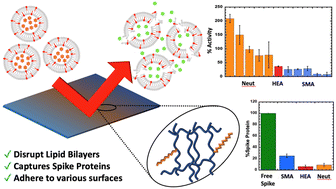Network polymers incorporating lipid-bilayer disrupting polymers: towards antiviral functionality†
Abstract
Designing a surface that can disinfect itself can reduce labor-intensive cleanings and harmful waste, and mitigate spread of surface borne diseases. Additionally, since COVID-19 is an airborne pathogen, surface modification of masks and filters could assist with infection control. Styrene-maleic acid (SMA) copolymers and their derivatives were shown to have lipid-bilayer disrupting properties, making them candidates as anti-viral materials. A series of network polymers with styrene-maleic acid-based polymers and control over polymer chain-length and composition were synthesized. All the polymers formed mechanically robust structures, with tunable Young's moduli on the order of MPa, and tunable swelling capability in water. The SMA-based bulk materials, containing a zwitterionic polar unit, showed excellent lipid disrupting properties, being up to 2 times more efficient than a 10% Triton solution. The highest performance was observed for materials with lower crosslink densities or shorter chain-lengths, with lipid disruption capability correlating with swelling ratio. Additionally, the material can capture the spike protein of SARS-CoV-2, with up to 90% efficiency. Both the lipid disrupting and spike protein capture ability could be repeated for multiple cycles. Finally, the materials are shown to modify various porous and non-porous substrates including surgical and KN95 masks. Functional network modified masks had up to 6 times higher bilayer disruption ability than the unmodified masks without inhibiting airflow.

- This article is part of the themed collection: Polymer Chemistry Lectureship Winners


 Please wait while we load your content...
Please wait while we load your content...